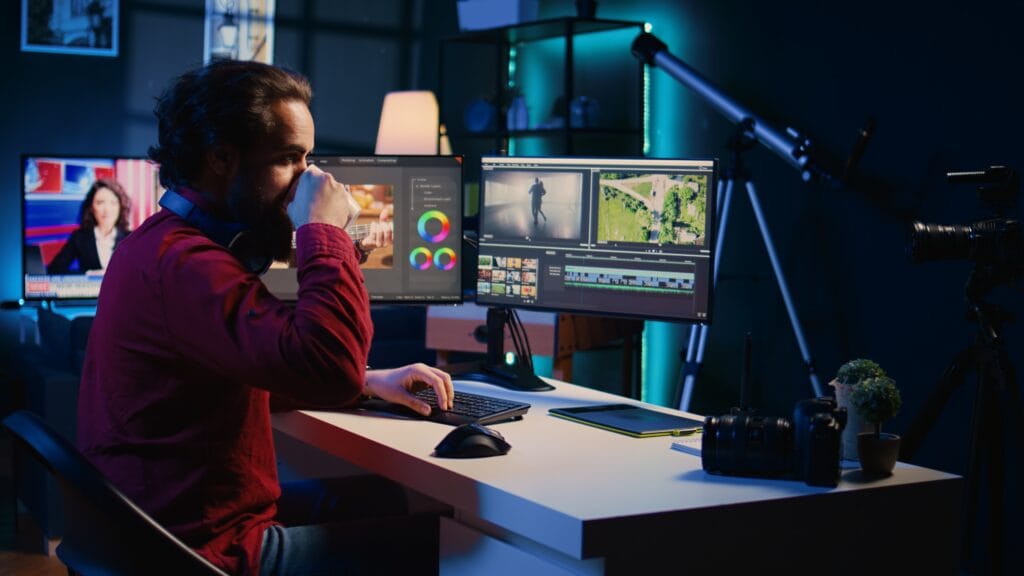Animation is one of the most influential forms of visual storytelling in the modern world. From the characters in our favorite films to the captivating advertisements we see online, animation shapes the way we experience media. But what is animation? At its core, animation is the art of creating moving images from still visuals, whether through drawings, models, or computer-generated graphics.
Animation is not just an art form; it has evolved into a powerful tool across various industries, from entertainment to education and marketing. In this post, we’ll explore the basics of animation, its history, types, applications, tools, and much more, including the distinction between what is 2D animation and what is 3D animation.
A Brief History of Animation
The history of animation dates back to ancient civilizations, where early animations took the form of sequential images on pottery, in cave drawings, and in early shadow plays. However, the true foundations of animation began in the 19th century with the invention of devices like the zoetrope and the phenakistoscope, which created the illusion of movement by displaying sequential images in quick succession.
The first breakthrough in animation came in 1908 with the release of Gertie the Dinosaur, created by Winsor McCay, which is often considered one of the first animated films in history. Since then, animation has grown into a multi-billion-dollar industry, with advancements in technology enabling the creation of lifelike characters, immersive worlds, and complex narratives.
The Evolution of Animation Through the Ages
Animation has come a long way since its humble beginnings. From hand-drawn frames to sophisticated CGI, animation has continued to evolve with technology. Major milestones include the introduction of color animation in the 1930s, the advent of 3D aimnation in the 1990s, and the growing use of AI and motion capture today. With every new innovation, animation has become more intricate, realistic, and capable of telling complex stories.
The Basic Concept of Animation
What Makes an Image Move?
The essence of animation lies in the illusion of movement. When multiple still images are shown rapidly one after another, our brains perceive the sequence as continuous motion. This trickery is what makes animation so unique. Whether it’s a simple flipbook or a complex 3D animation character, the principle of animating through frames remains at the heart of all animation.
Frame-by-Frame Principle
In traditional animation, each frame is individually created, whether by hand-drawing each image or generating computer graphics. The more frames per second (FPS), the smoother the animation will appear. Classic films, such as those created by Disney, used 24 frames per second to produce fluid motion, although modern films may use higher frame rates for enhanced detail.
Types of Animation
Traditional Animation
Traditional animation refers to the classic method of creating animation by hand-drawing or painting each frame. This labor-intensive process was used in many iconic animated films, such as The Lion King and Snow White and the Seven Dwarfs. Today, traditional animation is mostly used for artistic purposes and in niche markets, but its legacy continues to influence animation styles worldwide.
2D Animation
What is 2D animation? 2D animation, also known as flat animation, involves creating characters and scenes in a two-dimensional space. Historically done by hand-drawing each frame, 2D animation is now largely produced using digital software, which allows for easier manipulation of characters and backgrounds. Popular examples of 2D animation include shows like SpongeBob SquarePants and Rick and Morty.
3D Animation
What is 3D animation? 3D animation adds depth and dimension to the world of animation. Unlike 2D animation, which relies on flat images, 3D animation uses models that are created and manipulated in a virtual 3D space. 3D animation has revolutionized the animation industry with its ability to create highly realistic characters and environments. Films like Avatar and Toy Story are prime examples of 3D animation’s power.
Stop Motion Animation
Stop motion animation is a technique where objects or figures are physically manipulated frame by frame to create movement. Each frame is photographed and then played in sequence, creating the illusion of motion. Famous stop-motion films include The Nightmare Before Christmas and Coraline, which rely on meticulously crafted puppets and models.
Motion Graphics
Motion graphics is a subset of animation that involves creating animated graphic design elements, such as logos, icons, and text, often used in marketing videos, TV commercials, or online content. Unlike traditional animation, motion graphics typically don’t feature characters, but focus on moving text and shapes to convey messages.
Tools & Software Used in Animation
Industry-Standard Animation Tools
There are a variety of professional-grade tools used in the animation industry. Some of the most widely used software include:
Autodesk Maya – A powerful 3D animation and modeling tool used in film production and game design.
Adobe Animate – A top choice for 2D animation, allowing artists to create traditional and digital animations.
Blender – A free, open-source 3D animation creation suite that has gained popularity in both amateur and professional circles.
Toon Boom Harmony – Often used in traditional animation and 2D animation, offering a complete solution for animators.
Beginner-Friendly Animation Apps
For those just starting in animation, several beginner-friendly apps can help simplify the process:
Pencil2D – A free and easy-to-use 2D animation software for beginners.
FlipaClip – A mobile app that allows users to create 2D animations on smartphones and tablets.
Doodle Animator – Great for creating simple stop-motion animations and doodles on mobile devices.
Animation in Entertainment
Animation has become a staple in the entertainment industry, captivating audiences through the years. Iconic animated films like The Lion King, Frozen, and Zootopia have left lasting impressions. Meanwhile, the rise of 3D animation has led to films such as Avatar and Finding Nemo, which have redefined cinematic storytelling with their immersive visuals and rich narratives.
Animation in TV Shows and Cartoons
TV shows and cartoons, particularly those aimed at children, have solidified their place as one of the most beloved forms of animation. Shows like The Simpsons and Adventure Time have become cultural icons, maintaining a strong connection with both young and adult audiences alike.
Animation Beyond Entertainment
Animation in Education
In education, animation is a powerful tool for simplifying complex concepts and engaging students. By using animated content, educators can effectively explain intricate subjects such as science, history, and math, making the learning process more interactive and enjoyable.
Animation in Advertising and Marketing
In the world of marketing, logo animation is used to create compelling advertisements that capture attention and convey messages more effectively. Animated ads can explain products and services in a fun, digestible way, increasing engagement and customer retention. Logo animation is an essential tool in building strong, memorable brands.
Animation in Healthcare and Science
In healthcare and science, animation is used to illustrate complex medical procedures, biological processes, and scientific concepts. It can help professionals explain difficult topics to patients or the general public, improving understanding and communication.
Careers in Animation
Roles and Specializations
The animation industry offers a wide variety of career paths, including:
2D/3D Animators – The artists who create movement and animation for characters, objects, and environments.
Storyboard Artists – The creators of visual story outlines for animation projects.
Rigging Artists – Specialists who create digital skeletons for 3D models, allowing them to move realistically.
Concept Artists – The individuals responsible for designing characters, settings, and other visual elements.
Skills Required for Animators
Animators need a solid understanding of art, design, and technology. Some of the essential skills include:
Drawing and design skills (for 2D animation)
Knowledge of animation principles
Proficiency in animation software (e.g., Maya, Blender)
Creativity and storytelling abilities
Challenges in the Animation Industry
While animation offers immense creative possibilities, the industry also faces challenges. These include high production costs, tight deadlines, and the need to constantly innovate with new technologies. Additionally, the growing reliance on AI and automated tools may change the skill set needed for future animators.
The Future of Animation
AI and Animation
Artificial intelligence is beginning to play a larger role in animation, helping animators speed up the production process by automating tedious tasks like in-betweening or coloring. AI can also assist with the creation of realistic movements, improving efficiency without sacrificing creativity.
Virtual Reality and Immersive Experiences
As technology advances, virtual reality (VR) and immersive experiences are reshaping the future of animation. VR allows users to interact with animated worlds in real-time, creating new opportunities for storytelling, gaming, and education.
Conclusion
Animation is an ever-evolving art form that continues to captivate, educate, and entertain. From traditional animation to cutting-edge 3D animation and immersive VR experiences, animation plays a crucial role in numerous industries. Whether you’re interested in becoming an animator or simply appreciate the magic of animated content, understanding animation’s diverse forms and applications can deepen your appreciation of this fascinating medium.
FAQs
1. What is the difference between 2D animation and 3D animation?
2D animation involves creating flat, two-dimensional images, while 3D animation adds depth and dimension, making objects and characters appear more lifelike. 3D animation is used in films like Toy Story and is more immersive than 2D animation, which is commonly seen in cartoons.
2. How long does it take to create an animated film?
The time depends on the complexity of the project. 2D animation can take several months to a year, while 3D animation films can take 3-5 years, especially for high-budget projects like those from Pixar or Disney.
3. What are the best animation tools for beginners?
Beginner-friendly tools include:
Pencil2D: Great for 2D animation.
FlipaClip: A mobile app for easy 2D animation.
Blender: A free tool for 3D animation, though it has a steeper learning curve.
4. Can animation be used in education?
Yes, animation simplifies complex topics and engages students. It’s widely used in subjects like science, history, and math to enhance understanding and retention through 2D or 3D animations.
5. What career opportunities are available in animation?
Career roles include 2D/3D animators, concept artists, rigging artists, motion graphics designers, and VFX artists, with opportunities in film, TV, gaming, and advertising.






